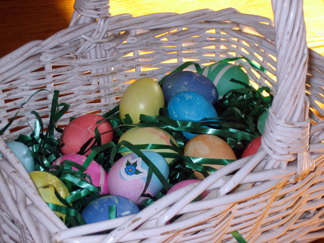
Which kits do kids love
– and which do moms prefer
There are many reasons why I wanted to have children.
Doing crafts isn’t one of them.
Making dolls out of fake flowers, yarn and pipe cleaners was
never my forte, even as a child. Today, my idea of being
”
crafty
”
is coming up with a good excuse when I forget to call my
mother.
Which kits do kids love – and which do moms prefer
There are many reasons why I wanted to have children.
Doing crafts isn’t one of them.
Making dolls out of fake flowers, yarn and pipe cleaners was never my forte, even as a child. Today, my idea of being “crafty” is coming up with a good excuse when I forget to call my mother.
So when I was asked if my daughters and I would be willing to conduct an Easter egg coloring kit comparison, my instinct was to say no. But then I figured, why not? We color eggs every year, and we’ve even tried a few artsy things, like wrapping rubber bands around the eggs before putting them into the dye (it leaves white stripes running every which way) and using glitter pens to decorate them.
My two daughters were excited to find out they would get to color eggs twice this year. When they realized it was for work, however, their main concern was that they would be able to eat the eggs. (They did. We had egg salad for dinner.)
For our comparison, we used three dozen hard-boiled eggs, three coloring kits, crayons, rubber bands, glitter pens, vinegar, two oranges and a red cabbage.
We started with the Paas Eggs-A-Glow coloring kit – which includes the typical dye tablets, decorative stickers, but also three packets of “glow in the dark” paint. The girls wrapped a few eggs in rubber bands and then dropped them into the color cups. They barely noticed the paint.
While they were doing this, I put on two pots of water to boil – one for orange peels and one for the cabbage – in an attempt to make natural dye. I was really hoping this would work – I’m always searching for healthy alternatives in snacks and lifestyle, and the idea of a natural dye appealed to me. I’ve always secretly wondered if the dye that seeps into the white through cracks in the eggshell could, oh, I don’t know, hurt me.
As the Paas eggs dried, the girls moved to the Glitter Egg kit, by Easter Unlimited. It comes with four dye tablets, liquid glue and glitter. They set an egg into the glue, then put it into a plastic bag of glitter and shook it. We realized quickly this isn’t all it’s cracked up to be. The glitter stuck to the eggs in clumps, and we weren’t able to do much more than six eggs before the glitter was gone. The concept is a good one, but for $1.99, I want to put glitter on more than six eggs.
The girls enjoyed the Paas kit, which was $2.99. They liked writing on the eggs and wrapping them in rubber bands, because it allowed them to show their personalities. Once the eggs dried, they used glitter pens to draw dots and squiggles. Glitter pens are around $5 a pack, depending on the size.
They also enjoyed Marble Eggs, by Easter Unlimited, but I’m not sure I like it. It comes with four paint packets and plastic gloves. But the egg has to be warm, which I didn’t realize, as no one in my family ever reads directions before starting a project. I spent about 10 minutes running eggs under hot water. Once the egg was warm, the girls put on gloves and we put drops of paint on the eggs. The girls rubbed the egg around in their hands to create a marble effect.
The marble eggs are pretty. However, you are meant to wear one glove at a time, roll eggs into a specific color until it is gone, take that glove off and work your way through the packets. I had the girls wear two gloves at a time, because I was sure they wouldn’t be able to roll an egg in one hand without dropping it. So this meant some of the colors were mixed. And like the glitter, the paint didn’t last long. We were able to do six marble eggs. If you are coloring a few dozen, like we do each year, you’d have to buy several kits at $1.99 each.
After the natural dye cooled, we put one egg into a cup of orange peel water and one into cabbage water. The orange peel water was a very pale yellow, while the cabbage water was a deep, deep blue. However, neither one really worked. The egg in the orange peel water turned a pale yellow. The cabbage dye didn’t work at all. I left the egg in the cup overnight, and the next morning, it was a faint blue. Also, two oranges and a head of cabbage came to $3.30, more than any of the kits.
In the end, we decided that the Paas kit was the best, not only in terms of color, but because of the creative options it gave us. We had fun, however, trying the different kits.
And we got dinner out of it.
BOX: Easter and eggs have long history
Information courtesy of The History channel Web site, www.history.com.
Grocery stores and mega-marts burst with Easter egg dye kits, chocolate eggs and plastic-shaped shells filled with everything from matchbox cars to candy during spring. The connection between spring and eggs stretches well past the first Easter celebration.
In many cultures throughout history, including the pagan cultures that ruled Europe before the spread of Christianity, eggs have long been connected with rebirth. Some cultures believed the world started as an enormous egg. Others such as the Nordics, saw eggs as a sign of fertility as flowers and animal life began to flourish each year in spring. In the middle ages, eggs were colored with natural dyes into bright colors to represent sunlight.
In the Middle East and Greece, some cultures painted eggs bright red to symbolize the blood of Christ. In Eastern Europe, hollow eggs were decorated with pictures of religious figures. Hard-boiling eggs is thought to have come out of the Lenten tradition – when Catholics did not eat meat or dairy during the weeks leading up to Easter. It allowed a way to preserve all the eggs chickens laid throughout the season.
In Poland and the Ukraine, eggs are painted silver and gold, with wax patterns used on the egg to produce stripes and other patterns.
Colored eggs became especially popular in German culture in the 16th century when sweethearts would decorate eggs for each other as a gift. German immigrants are credited with spreading the tradition in America.
These days bright-colored eggs are still synonymous with spring.







